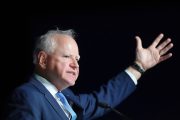Although Senate Republicans rejected cybersecurity legislation last week, President Obama may yet rule on the issue, once again bypassing the legislative branch and the separation of powers set out in the Constitution.
According to a report in The Hill, President Obama is mulling the issuing of an executive order to create “law” where Congress failed to do so.
“In the wake of Congressional inaction and Republican stall tactics, unfortunately, we will continue to be hamstrung by outdated and inadequate statutory authorities that the legislation would have fixed. Moving forward, the President is determined to do absolutely everything we can to better protect our nation against today’s cyber threats and we will do that,” White House Press Secretary Jay Carney said in an email.
The demise of the bill in the Senate was not unforeseen. As The New American reported late last month:
The Cybersecurity Act of 2012 has been the subject of some criticism as privacy advocates feared that the bill would pose too many threats to the constitutional rights of the American people.
Likewise, the U.S. Chamber of Commerce and IBM sent out letters to show their opposition for the original bill, asserting that it would overwhelm the industry with regulations.
In response to the criticism, Senator Lieberman reformed the original bill.
For example, the updated version of the bill reflects changes to the provision to assign the Department of Homeland Security the role of creating mandatory cybersecurity standards for infrastructure industries.
The newer version of the bill does not include language for “mandatory, regulatory sections,” but still requires a creation of industry best practice standards for the purposes of protecting critical infrastructure, but rather than making the adoption of those standards mandatory, the owners of the critical infrastructure adopt “voluntary” standards. The bill offers incentives to adopt those standards, such as liability protection, and access to threat information.
Some contend that the revisions are not ideal, however, as it gives the government the power to deny threat information to critical infrastructure owners who choose not to comply with the voluntary standards. Likewise, the incentives are too insignificant to fully incentivize any company to adopt the standards.
Since the beginning of his administration, President Obama has made cybersecurity a central plank in his presidential platform. As The New American reported in 2009:
The president pointed out that shortly after taking office he directed the National Security Council and Homeland Security Council to thoroughly review the federal government’s efforts “to defend our information and communications infrastructure” and to recommend improvements. He mentioned that National Security Council Acting Senior Director for Cyberspace Melissa Hathaway led the review team, and that the 60-day review included input from industry, academia, civil liberty and privacy advocates, every level and branch of government, Congress, and other advisers — even input from “international partners.”
To that end, the White House proposed legislation in 2011 and has ordered one after the other administration official to testify at no fewer than 17 congressional hearings on the subject.
In a recent Wall Street Journal opinion piece penned by the president, he did his best to instill in the American people fear of the consequences we would suffer should someone launch a successful cyberattack on the critical infrastructure networks of our nation.
Should the President decide to exercise the executive order option that for this White House is always on the table, it is unlikely that any Democratic lawmakers will oppose this usurpation of their legislative powers.
For example, Senator Dianne Feinstein (D-Calif.), one of the main co-sponsors of the Cybersecurity Act, has said that while she prefers that Congress act to pass appropriate legislation, she, too, believes it is the president’s prerogative to fill the congressional vacuum. “I suppose if we can’t, the answer would be yes,” she said when asked whether she would back the president’s signing of a cybersecurity executive order.
While Senator Feinstein’s tepid seal of approval may please the president, he has never been one to let the Constitution stand in the way of the codification of his agenda.
As we reported in 2010, President Obama was fed up trying to convince, cajole, and compromise with the Republican Party in order to garner its rubber-stamp enshrinement of his legislative legacy, so, in his exasperation, he issued an executive order and began ruling by fiat.
Although during his campaign for president Barack Obama criticized (and rightly so) former President Bush for his dictatorial usurpation of legislative power via the signing statement, his own experience with occasional congressional resistance to his agenda has given him second thoughts about the utility of these signing statements and executive orders as ways to make successful end runs around the Constitution.
More recently, on June 15 President Obama ignored Congressional failure to pass the DREAM Act and announced his administration’s intent to “mend our nation’s immigration policy” and issued an order that effective immediately, the Department of Homeland Security was to begin taking steps to
lift the shadow of deportation from these young people. Over the next few months, eligible individuals who do not present a risk to national security or public safety will be able to request temporary relief from deportation proceedings and apply for work authorization.
While this proclamation amounted to nothing less than the opening of a back door to amnesty, it was an example of President Obama demonstrating his determination to stand by his “We Can’t Wait” slogan when it comes to waiting on Congress to legislate on matters he considers more important than the Constitution.
The Father of the Constitution disagrees, however. James Madison, writing as “Publius,” famously stated in The Federalist, No. 47: “The accumulation of all powers legislative, executive and judiciary in the same hands, whether of one, a few or many, and whether hereditary, self appointed, or elective, may justly be pronounced the very definition of tyranny.”
As the venerable French philosopher Baron de Montesquieu wrote in his influential treatise l’Esprit des Lois (The Spirit of the Laws), “When the legislative and executive powers are united in the same person, or in the same body of magistrates, there can be no liberty; because apprehensions may arise, lest the same monarch or senate should enact tyrannical laws, to execute them in a tyrannical manner.”
“Centinel,” the nom de guerre of an anti-Federalist opposed to ratifying the new Constitution, rephrased for his readers what was already, in the 18th century, a well-settled aspect of good government, “This mixture of the legislative and executive moreover highly tends to corruption. The chief improvement in government, in modern times, has been the complete separation of the great distinctions of power; placing the legislative in different hands from those which hold the executive.”
If the opinions of these men are an accurate gauge of the size of the impending threat of despotism, then President Obama is filling the shoes of a tyrant heel to toe. And his decision to repeatedly and unilaterally demolish the walls of history, law, and constitutional enumerations that separate the executive and legislative powers is compelling evidence of his intent to march on down the path of despotism by decree pioneered by so many of his predecessors.
As one writer observed regarding President Obama’s likely issuance of an executive order to “rule” on issues of cybersecurity, “But, once again, it looks like the concept of “separation of powers” will be discarded, because the Unitary Executive thinks it’s really important to do something. Legislators apparently get to weigh in only when they reach decisions the President approves of, or debate issues that don’t capture his attention.”
Photo: President Barack Obama speaks at a campaign fundraiser in Stamford, Conn., Aug., 6, 2012 : AP Images




